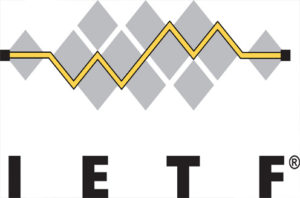
Date: 01/01/1985Internet Engineering Task Force Requests for Comments (RFCs) started as memoranda addressing the various protocols that facilitate the functioning of the Internet and were previously edited by the late Dr. Postel aspart of his IANA functions. The IETF started in January1985 as a quarterly meeting of U.S. government funded researchers. Representatives from non-government vendors were invited starting with the fourth IETF meeting inOctober of that year. In 1992, the Internet Society, a professional membership society, was formed and the IETF was transferred to operation under it as an independent international standards body.
When generic top-level domains were first implemented, in January 1985, there were six: .com .edu .gov .mil .net .org While .net wasnot listed in the original RFC document describing the domain name system, it was added by the time the first group of names were implemented. The .com,.net, and .org gTLDs, despite their original different uses, are now in practice open for use by anybody for any purpose. 1986 NPL replaced Donald Davies of the National Physical Laboratory (United Kingdom) proposed anational data network based on packet-switching. The proposal was not taken up nationally, but by 1970 he had designed and built the Mark I packet-switched network to meet the needs of the multi disciplinary laboratory and prove the technology under operational conditions. By 1976 12 computers and 75 terminal devices were attached and more were added until the network was replaced in 1986.
In 1981 NSF supported the development ofthe Computer Science Network (CSNET). CSNET connected with ARPANET usingTCP/IP, and ran TCP/IP over X.25, but it also supported departments without sophisticated network connections, using automated dial-up mail exchange. Itsexperience with CSNET lead NSF to use TCP/IP when it created NSFNET, a 56kbit/s backbone established in 1986, that connected the NSF supported super computing centers and regional research and education networks in theUnited States. However, use of NSFNET was not limited to supercomputer users and the 56 kbit/s network quickly became overloaded. NSFNET was upgraded to 1.5Mbit/s in 1988. The existence of NSFNET and the creation of Federal Internet Exchanges (FIXes) allowed the ARPANET to be decommissioned in 1990. NSFNET was expanded and upgraded to 45 Mbit/s in 1991, and was decommissioned in 1995 whenit was replaced by back bones operated by several commercial Internet Service Providers.
Access to the ARPANET was expanded in 1981 when the National Science Foundation (NSF) developed the Computer Science Network (CSNET) and again in 1986 when NSFNET provided access to supercomputer sites inthe United States from research and education organizations. Commercial internet service providers (ISPs) began to emerge in the late 1980s and 1990s. TheARPANET was decommissioned in 1990. The Internet was commercialized in 1995 when NSFNET was decommissioned, removing the last restrictions on the use ofthe Internet to carry commercial traffic.